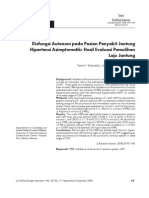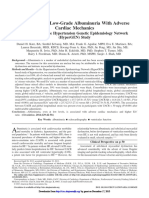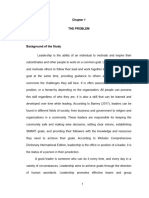Sako 2011
Sako 2011
Uploaded by
Jake WilsonCopyright:
Available Formats
Sako 2011
Sako 2011
Uploaded by
Jake WilsonOriginal Title
Copyright
Available Formats
Share this document
Did you find this document useful?
Is this content inappropriate?
Copyright:
Available Formats
Sako 2011
Sako 2011
Uploaded by
Jake WilsonCopyright:
Available Formats
e490 Journal of Hypertension Vol 29, e-Supplement A, June 2011
Results: Although baseline values of E/E’ in H and C group were in normal less free time events in the LVH group. Concentric LVH has a worse progno-
limits (< 8), compared to controls H patients had higher E/E’ ratio at rest sis: RTI 3.99, 2.69 to 5.91). LVH with dipper profile increased events (IRR:
(5.5 ± 0.77 vs. 4,25 ± 0.83, p < 0.001). In C group E/E’ ratio did not increase 7.19 [3.29 to 15.74]); and non-dipper and riser profiles with LVH (12.18 [5.77
during exercise. Out of 55 hypertensive pts 38(69%) had no increase in E/E’ to 25.72] and 20,98 [9.81 to 44.91]) and without LVH (9.16 [4.15 to 20.24]
during exercise, while exercise E/E’ rised in 17(31%) pts (from 6.2 ± 0.48 to and 25.41 [9.31 to 72.75]) increase the risk. The Cox regression analysis
10.1 ± 1.06, p < 0.0001; difference 63%). The percentage of dyspnea as a showed that only the nocturnal BP decrease (OR [95% CI]: 0.97 [0.95 to 0.98],
primary reason for stopping exercise was similar in hypertensive pts with and p = 0.0007) and LVMI (OR [95% ] 1.02 [1.01 to 1.03], p < 0.0001) influenced
those without exercise increased E/E’. However, exercise duration was sig- in the patients prognosis.
nificantly shorter in hypertensive pts with than in pts without raised exercise
E/E’ (p < 0.025). Conclusions: The loss of the depth of blood pressure is the parameter that is
associated with poor CV prognosis in hypertensive patients. The presence of
Conclusion: In hypertensive patients with preserved global LV diastolic LVH determined a higher incidence of cardiovascular events. Although eccen-
function at rest, increased E/E’ during diastolic stress echocardiography may tric LVH is the most common, the concentric LVH is associated with increased
uncover those with subclinical diastolic dysfunction. cardiovascular risk.
PP.36.204 CAN THE SILENT MYOCARDIAL ISCHEMIA BE PP.36.206 ASSOCIATION BETWEEN EAS INDEX BY TISSUE
DETECTED IN ARTERIAL HYPERTENSIVE PATIENTS DOPPLER IMAGING AND VENTRICULAR STIFFNESS
WITH LEFT VENTRICULAR REMODELING? INDEX OR VENTRICULOARTERIAL INTERACTION
S. Gurgenyan, S. Vatinyan, K. Nikoghosyan. Institute f Cardiology, Yerevan- H. Sako, S. Miura, K. Saku. Fukuoka University Hospital, Fukuoka-Japan
Armenia
Objectives: Aortic stiffening contributes to cardiac afterload, left ventricular
Objective: Left ventricular (LV) hypertrophy often accompany with myocardial (LV) hypertrophy and substrate of cardiac function. We previously reported that
ischemia (MI). The aims of present study is to demonstrate that the symptoms of Eas Index by tissue doppler imaging (TDI) was associated with aortic stiffness
MI subsist in arterial hypertensive (AH) patients (pts) with LVH without clini- by transesophageal echocardiography and augmentation index. The purpose of
cally coronary arterial disease (CAD). this study was to evaluate the association between Eas index and LV elastance or
ventriculoarterial interaction.
Design and Method: We studied 43 pts with moderate AH (24 male and
19 female, mean age 52.1 ± 9.1 years). In all pts were performed 24-h ECG Methods and Results: We evaluated cardiac function by both conventional
Holter monitoring, in 40 - bicycle exercise ECG (begun with 25 W, increasing echocardiography and TDI velocities from 2 mitral annular sites in consecu-
by 25 W every 4 min), in 39 were evaluated the changes of wall motion score tive 300 patients. TDI velocities were quantified by Eas index of diastolic and
index (WMCI) at rest and at peak by the dobutamine stress-echocardiography systolic performance: e’ /(a’xs’). We also examined LV diastolic elastance
(SE), in 26 - the myocardial scintigraphy by use of 99mTc– pyrophosphate and in index (Ed), arterial elastance index (Ea), LV end-systolic elastance index
17 - 103TL and in 19 – coronary angiography. (Ees), ventricular- vascular coupling index (10xEa/Ees) and total stiffness
index (10xEdxEa/Ees). The Eas index was significantly correlated with Ed
Results: Fifty (34.8%) pts had an episode of SI in 24-h ECG Holter monitor- (r = -0.470, p < 0.0001), Ea (r = -0.198, p = 0.035) and total stiffness index
ing. Twenty (46.5.%) pts had > 0.1 mV of ST-segment depression and negative (r = -0.272, p = 0.003). However, Ees and ventricular-vascular coupling index
T wave in V5 and V6 in exercise ECG relative to the rest. The WMCI was were not associated with Eas index. Finally, multivariate logistic regression
observed in 9 (20.9%) pts at rest and in 27 (62.7%) – at peak (was deter- analysis showed that plasma levels of brain natriuretic peptide were most
mined by new wall motion abnormalities). In 22 (51.1%) pts the myocardial closely correlated with Ed (p = 0.004).
scintigraphy reveal the myocardial ischemic injuries. In 19 AH pts with LV
remodeling and SI parameters with clinic diagnosis of the attendant CAD were Conclusions: The Eas index for TDI may be a helpful tool for evaluating aortic
performed coronary angiography. In 15 pts were excluded CAD events and stiffness, cardiac afterload and diastolic LV function.
only in 4 of them was confirmed the CAD diagnosis.
Conclusions: In the absence of CAD the MI events in AH pts are presented PP.36.207 TISSUE DOPPLER INDEXES OF LEFT VENTRICULAR
as a result of LV remodeling and as possible is related with anomalies of SYSTOLIC FUNCTION IN RELATION TO THE
coronary microcirculation. Non-invasive diagnostic tests for detect of CAD PULSATILE AND STEADY COMPONENTS OF BLOOD
are not always adequate in AH pts. If diagnostic doubt preserves after the PRESSURE IN A GENERAL POPULATION
loaded test or a myocardial scintigraphy in AH pts coronary angiography can
be necessary. T. Kuznetsova1, W. Sakiewicz2, M. Kloch-Badelek3, J. Dhooge1, A. Ryabikov4,
K. Kunicka2, E. Swierblewska2, L. Thijs1, S. Malyutina4, K. Stolarz-
Skrzypek3, K. Kawecka-Jaszcz3, K. Narkiewicz2, J.A. Staessen1. 1University
PP.36.205 PROGNOSTIC VALUE OF LEFT VENTRICULAR of Leuven, Leuven-Belgium, 2Medical University of Gdansk, Gdansk- Poland,
3
HYPERTROPHY AND BLOOD PRESSURE Jagiellonian University Medical College, Cracow-Poland, 4Institute of Internal
VARIABILITY Medicine, Novosibirsk-Russia
S. Cinza Sanjurgo1, A. Hermida Ameijeiras2, Je López Paz2, M. Pena Seijo2, Objective: To our knowledge, no population study described the association of
G. Calvo González2, Ml Romero Miguez2, V. Martinez Durán2, A. Pascual the radial and longitudinal components of left ventricular (LV) strain with blood
Montes2, J.M. Paz Fernández2, C. Calvo Gómez2. 1Malpica Health Center, pressure (BP) in continuous analyses. We therefore investigated these associa-
Malpica-Spain, 2University Hospital Complex of Santiago, Santiago De tions in subjects randomly recruited from the general population in the frame-
Compostela-Spain work of the family-based European Project on Genes in Hypertension.
Introduction and Objectives: Left Ventricular Hypertrophy (LVH) is the earli- Design and Method: In 303 subjects (51.5% women; mean age, 43.0 year),
est manifestation of cardiac effect in hypertensive patients and is an independent using Tissue Doppler Imaging (TDI), we measured:1 end-systolic longitudi-
risk factor for cardiovascular complications. The objective of this study was to nal strain (mean, 21.0%) and peak systolic strain rate (SR) (1.29 1/s) from
determine the prognosis cardiovascular (CV) of hypertensive patients with LVH, the basal portion of the LV inferior and posterior free walls;2 and radial stain
based on the variability of blood pressure (BP) assessed by ABPM. (51.1%) and SR (3.40 1/s) of the LV posterior wall. Models included in addi-
tion to covariables and confounders both systolic and diastolic BPs or both
Methods: Cohort study in a sample of 432 hypertensive patients (218 women, pulse pressure (PP) and mean arterial pressure (MAP). Effect sizes were
55.5 years) and without cardiovascular disease (CV) prior. In all cases, clinical expressed per 1-SD increase in BP.
assessment and biological, ABPM-24h and echocardiography (Pen conven-
tion, with calculation of left ventricular mass index-LVMI, normalized for Results: Longitudinal strain (–0.72%; P = 0.03 and –0.76%; P = 0.005), but
body surface area and height-SC-AL). The monitoring of patients was per- not SR, decreased with diastolic BP and MAP. Radial strain (4.5% and –3.5%;
formed by review of medical history, recording the type of event (peripheral P ≤ 0.001) and SR (0.36 1/s and –0.21 1/s; P ≤ 0.03) independently increased
arterial disease, PAD, Coronary Disease-CD, heart failure-HF or stroke) and with systolic BP and decreased with diastolic BP. Accordingly, radial strain
recording the event date. (3.1%; P < 0.0001) and SR (0.22 1/s; P = 0.0007) increased with higher PP, but
were not related to MAP.
Results: Completed follow-up 405 patients (218 women, mean age 55.5
years). Patients with LVH have more events, IT = 5.99 compared to 3.06 for Conclusions: In the general population, BP is an independent determinant of
those without LVH (IRR: 1.96 [1.42 to 2.72]). The Kaplan-Meier curve shows LV systolic function as measured by TDI. Radial function increased with PP,
You might also like
- BBB Month 52 Lower Upper Workout PlanDocument7 pagesBBB Month 52 Lower Upper Workout PlanBurcu Senol100% (1)
- Maruti Suzuki Alto 800 Lxi Service ManualDocument128 pagesMaruti Suzuki Alto 800 Lxi Service ManualDivender Parmar67% (6)
- A Speckle Tracking Echocardiographic Study For Correlation Between Global Left Ventricular Strain and Severity of Aortic StenosisDocument7 pagesA Speckle Tracking Echocardiographic Study For Correlation Between Global Left Ventricular Strain and Severity of Aortic StenosisPremier PublishersNo ratings yet
- Impaired Left Ventricular Apical Rotation Is Associated With Disease Activity of Psoriatic ArthritisDocument8 pagesImpaired Left Ventricular Apical Rotation Is Associated With Disease Activity of Psoriatic ArthritisEmanuel NavarreteNo ratings yet
- Strain Values For LV by Age and Gender 2016Document11 pagesStrain Values For LV by Age and Gender 2016moulemNo ratings yet
- Chen 2001Document7 pagesChen 2001enriquegarciagalianaNo ratings yet
- Effect of Right Ventricular Function and Pulmonary Pressures On Heart Failure PrognosisDocument7 pagesEffect of Right Ventricular Function and Pulmonary Pressures On Heart Failure PrognosisMatthew MckenzieNo ratings yet
- EHB 2015 Paper 157Document4 pagesEHB 2015 Paper 157Cringuta ParaschivNo ratings yet
- Mond Illo 2011Document11 pagesMond Illo 2011Triệu Khánh VinhNo ratings yet
- Presentasi JurnalDocument19 pagesPresentasi JurnalReggie Christian GNo ratings yet
- Lvedp in AmiDocument3 pagesLvedp in AmiFaisol SiddiqNo ratings yet
- Hs 15069Document4 pagesHs 15069Deepak RanaNo ratings yet
- Moderate To Severe ASDocument7 pagesModerate To Severe ASTheresia Sri RezekiNo ratings yet
- ECG and VCG in Left Ventricular Hypertrophy LVHDocument78 pagesECG and VCG in Left Ventricular Hypertrophy LVHNguyen TuanNo ratings yet
- 1 s2.0 S0002914915018445 MainDocument8 pages1 s2.0 S0002914915018445 MainFaomix de la HouseNo ratings yet
- High Prevalence of Subclinical Left Ventricular Dysfunction in Patients With Psoriatic ArthritisDocument8 pagesHigh Prevalence of Subclinical Left Ventricular Dysfunction in Patients With Psoriatic ArthritisEmanuel NavarreteNo ratings yet
- Pseudonormalization: Clinical, Electrocardiographic, Echocardiographic, and Angiographic CharacteristicsDocument3 pagesPseudonormalization: Clinical, Electrocardiographic, Echocardiographic, and Angiographic CharacteristicspavithranmbbsNo ratings yet
- Prognostic Role of Subclinical Left Ventricular Systolic Dysfunction Evaluated by Speckle-Tracking Echocardiography in Rheumatoid ArthritisDocument10 pagesPrognostic Role of Subclinical Left Ventricular Systolic Dysfunction Evaluated by Speckle-Tracking Echocardiography in Rheumatoid ArthritisEmanuel NavarreteNo ratings yet
- SEHGAL 2016 - A New Look at Bronchopulmonary Dysplasia - Post Capillary Pathophysiology and Cardiac DysfunctionDocument8 pagesSEHGAL 2016 - A New Look at Bronchopulmonary Dysplasia - Post Capillary Pathophysiology and Cardiac DysfunctionRafael JustinoNo ratings yet
- Main 51 ???Document5 pagesMain 51 ???pokharelriwaj82No ratings yet
- 228A ABSTRACTS - Cardiac Function and Heart Failure Jacc March 3, 2004Document2 pages228A ABSTRACTS - Cardiac Function and Heart Failure Jacc March 3, 2004Yulianty Saulina FransiscaNo ratings yet
- Agus Logistik RegresiDocument8 pagesAgus Logistik RegresiTeuku AgungNo ratings yet
- NXMCBDocument6 pagesNXMCBDianNo ratings yet
- The Role of Echocardiographic Study in Patients With Chronic Kidney DiseaseDocument9 pagesThe Role of Echocardiographic Study in Patients With Chronic Kidney DiseaseshodhgangaNo ratings yet
- Leong2015 Hub Total Waktu Iskemik LVMD Dan AritmiaDocument8 pagesLeong2015 Hub Total Waktu Iskemik LVMD Dan AritmiaauliaNo ratings yet
- Electrocardiograph Changes in Acute Ischemic Cerebral StrokeDocument6 pagesElectrocardiograph Changes in Acute Ischemic Cerebral StrokeFebniNo ratings yet
- Jurnal KardiovaskularDocument6 pagesJurnal Kardiovaskularrizk86No ratings yet
- Assessment of Palpitation Complaints Benign Paroxysmal Positional VertigoDocument6 pagesAssessment of Palpitation Complaints Benign Paroxysmal Positional VertigoHappy PramandaNo ratings yet
- Braunwald: Chronic Coronary Artery DiseaseDocument122 pagesBraunwald: Chronic Coronary Artery Diseaseusfcards100% (1)
- Lupus Myocarditis Presenting As Acute Congestive Heart FailureDocument3 pagesLupus Myocarditis Presenting As Acute Congestive Heart FailurehafifanisaNo ratings yet
- 1787 FullDocument1 page1787 FullNITACORDEIRONo ratings yet
- The Value of A New Speckle Tracking Index Including Left Ventricular Global Longitudinal Strain and Torsion in Patients With Dilated CardiomyopathyDocument8 pagesThe Value of A New Speckle Tracking Index Including Left Ventricular Global Longitudinal Strain and Torsion in Patients With Dilated Cardiomyopathymarsim92No ratings yet
- Falso Tendão No VE e Repolarização VentricularDocument1 pageFalso Tendão No VE e Repolarização VentricularNITACORDEIRONo ratings yet
- J Jacc 2013 08 1622Document6 pagesJ Jacc 2013 08 1622Triệu Khánh VinhNo ratings yet
- 1 s2.0 S0026049520303425 MainDocument1 page1 s2.0 S0026049520303425 MainAnshum GuptaNo ratings yet
- Pathophysiology of COPDDocument4 pagesPathophysiology of COPDrinieeeNo ratings yet
- ICRJ-Validation of Cornell Product As A Method of Assessing Left Ventricular HypertrophyDocument5 pagesICRJ-Validation of Cornell Product As A Method of Assessing Left Ventricular Hypertrophysamir raflaNo ratings yet
- EE Pac Con FADocument6 pagesEE Pac Con FAGuillermo CenturionNo ratings yet
- Christersson2022 Article ScreeningForBiomarkersAssociatDocument11 pagesChristersson2022 Article ScreeningForBiomarkersAssociatS FznsNo ratings yet
- Myocardial Work in Nonobstructive Hypertrophic Cardiomyopathy: Implications For OutcomeDocument8 pagesMyocardial Work in Nonobstructive Hypertrophic Cardiomyopathy: Implications For Outcomeme1921No ratings yet
- Association of Low-Grade Albuminuria With Adverse Cardiac MechanicsDocument14 pagesAssociation of Low-Grade Albuminuria With Adverse Cardiac MechanicsM. Ryan RamadhanNo ratings yet
- Changes in Mitral Annular Ascent WithDocument5 pagesChanges in Mitral Annular Ascent WithMiguelNo ratings yet
- 1 s2.0 S1878648013709881 MainDocument1 page1 s2.0 S1878648013709881 MainmmsNo ratings yet
- Relatia Dintre Arteroscleroza Si Colesterol SericDocument7 pagesRelatia Dintre Arteroscleroza Si Colesterol SericBeniamin BorotaNo ratings yet
- Article2017ICMBoissier DysfonctionVGSepticshockDocument10 pagesArticle2017ICMBoissier DysfonctionVGSepticshockenriquegarciagalianaNo ratings yet
- Omur - Tc-99m MIBI Myocard Perfusion SPECT Findings in Patients With Typical Chest Pain and Normal Coronary ArteriesDocument8 pagesOmur - Tc-99m MIBI Myocard Perfusion SPECT Findings in Patients With Typical Chest Pain and Normal Coronary ArteriesM. PurnomoNo ratings yet
- 10.1007@s10554 020 01913 6Document10 pages10.1007@s10554 020 01913 6Bosman AriestaNo ratings yet
- Pjms 31 159Document5 pagesPjms 31 159christ_cruzerNo ratings yet
- White-Coat Hypertension, As Defined by Ambulatory Blood Pressure Monitoring, and Subclinical Cardiac Organ Damage: A Meta-AnalysisDocument9 pagesWhite-Coat Hypertension, As Defined by Ambulatory Blood Pressure Monitoring, and Subclinical Cardiac Organ Damage: A Meta-AnalysisyuyunzilaNo ratings yet
- Potter 2021Document12 pagesPotter 2021PA7 - EXAMNo ratings yet
- Serum CytokinesDocument7 pagesSerum CytokinesEvy Yulia KusmayantiNo ratings yet
- Cardiovascular Manifestations in Patients With Systemic Lupus ErythematosusDocument5 pagesCardiovascular Manifestations in Patients With Systemic Lupus ErythematosusIOSRjournalNo ratings yet
- Prognosis of PiDocument7 pagesPrognosis of PiGhea SugihartiNo ratings yet
- 10.0000@Www - Jstage.jst - Go.jp@Article@Ihj@56@1@5614 175@articleDocument4 pages10.0000@Www - Jstage.jst - Go.jp@Article@Ihj@56@1@5614 175@articleEkaSetyaningsihNo ratings yet
- Relationship Between Platelet-To-Lymphocyte Ratio and The Presence and Severity of Coronary Artery EctasiaDocument6 pagesRelationship Between Platelet-To-Lymphocyte Ratio and The Presence and Severity of Coronary Artery EctasiaAlamgirNo ratings yet
- Peguero-Lo Presti Criteria Modified by Body Surface Area For The Electrocardiographic Diagnosis of Left Ventricular Hypertrophy in Thai PatientsDocument7 pagesPeguero-Lo Presti Criteria Modified by Body Surface Area For The Electrocardiographic Diagnosis of Left Ventricular Hypertrophy in Thai Patientsdanish.mahaitNo ratings yet
- M R The Association of Blood Urea Nitrogen Levels and Coronary Artery DiseaseDocument5 pagesM R The Association of Blood Urea Nitrogen Levels and Coronary Artery DiseaseTanveerNo ratings yet
- The Relation of Echo-Derived Lateral MAPSE To Left Heart Functions and Biochemical Markers in Patients With Preserved Ejection Fraction Short-Term Prognostic ImplicationsDocument8 pagesThe Relation of Echo-Derived Lateral MAPSE To Left Heart Functions and Biochemical Markers in Patients With Preserved Ejection Fraction Short-Term Prognostic ImplicationsMiguelNo ratings yet
- Jurnal OmiDocument14 pagesJurnal OmiYogie YahuiNo ratings yet
- Liver Stiffness As Measured by Transient Elastography - 2021 - American Heart JDocument6 pagesLiver Stiffness As Measured by Transient Elastography - 2021 - American Heart JGarret BarriNo ratings yet
- Kim 2000Document6 pagesKim 2000Theresia Sri RezekiNo ratings yet
- Strawberry DNA LabDocument2 pagesStrawberry DNA LabChelsey PavaoNo ratings yet
- Confidential 3501132: Appen - Person/Object SegmentationDocument16 pagesConfidential 3501132: Appen - Person/Object SegmentationStephen Velasco VillaruzNo ratings yet
- TRANSITIONAL Words, Fanboys,+dependent+wordsDocument1 pageTRANSITIONAL Words, Fanboys,+dependent+wordsBobbyNicholsNo ratings yet
- 1543 ToniPRAXDocument2 pages1543 ToniPRAXSherif ShahinNo ratings yet
- Admission Schedule: CCB: RC: PI: Gfi: SfiDocument6 pagesAdmission Schedule: CCB: RC: PI: Gfi: Sfirahul989No ratings yet
- Richmond County Property Transfers Sept. 12 - 18Document4 pagesRichmond County Property Transfers Sept. 12 - 18augustapressNo ratings yet
- Kota Makassar TerbaruDocument1,258 pagesKota Makassar TerbaruratnoNo ratings yet
- Physics Form 1 QuestionsDocument10 pagesPhysics Form 1 QuestionsOkumu KevinsNo ratings yet
- Fudge Dice Miniature SystemDocument7 pagesFudge Dice Miniature Systeml laNo ratings yet
- Curriculum Vitae PDFDocument3 pagesCurriculum Vitae PDFKetutTomySuhariNo ratings yet
- 2017 Safariland CatalogDocument76 pages2017 Safariland CatalogOld_RomadNo ratings yet
- Sprinter 7G Tronic TransmissionDocument7 pagesSprinter 7G Tronic TransmissionRicardo Santo AntonioNo ratings yet
- Massively Multiplayer Online Role Playing Game (MMORPG)Document14 pagesMassively Multiplayer Online Role Playing Game (MMORPG)Sumardi FnuNo ratings yet
- 3.1 The First FleetDocument12 pages3.1 The First FleetMike YaraNo ratings yet
- VD ReportDocument18 pagesVD Reportviraj21mechNo ratings yet
- Data Sheet Sensors VEK S4 S4CDocument2 pagesData Sheet Sensors VEK S4 S4Cbadeaioana70No ratings yet
- Pain Gate TheoryDocument28 pagesPain Gate Theorysahinuri348No ratings yet
- MBot V1 1 Blue STD Shuo Ming Shu en D1 2 2-7-40 4100 Edit 1 CCDocument24 pagesMBot V1 1 Blue STD Shuo Ming Shu en D1 2 2-7-40 4100 Edit 1 CCToan VuNo ratings yet
- Biomass As An Energy SourceDocument24 pagesBiomass As An Energy Sourceodebunmi taiwoNo ratings yet
- OAF Getting StartedDocument4 pagesOAF Getting StartedRedo KmNo ratings yet
- Taller 2Document4 pagesTaller 2CCJNo ratings yet
- Ancient HistoryDocument60 pagesAncient Historyn.ploegmanNo ratings yet
- NRM 411Document2 pagesNRM 411freedNo ratings yet
- Policy Formulation and EvaluationDocument12 pagesPolicy Formulation and EvaluationJanice Inquiangco CalucagNo ratings yet
- The Speed of GravityDocument8 pagesThe Speed of GravitymasharecoNo ratings yet
- ChanakyaDocument24 pagesChanakyahotrev86No ratings yet
- Import & Export ManagementDocument21 pagesImport & Export ManagementManjeet Ojha0% (1)
- Chapter 1 2 Ito Yung PinassDocument47 pagesChapter 1 2 Ito Yung PinassJohn aries SOLANONo ratings yet

























































































